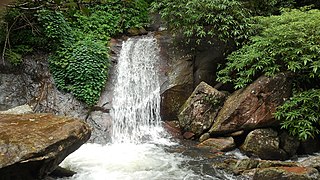Nelliyampathy
Nelliampathi | |
|---|---|
Hill Station | |
| Nelliampathi | |
 Western Ghats at Nelliampathi | |
| Nickname: Nelliampathi | |
| Coordinates: 10°31′47″N 76°41′02″E / 10.529627°N 76.684012°E | |
| Country | |
| State | Kerala |
| District | Palakkad |
| Named for | Nelliampathi |
| Government | |
| • Body | Gram Panchayat |
| Area | |
| • Total | 576 km2 (222 sq mi) |
| Population (2011)[1] | |
| • Total | 5,545 |
| • Density | 9.6/km2 (25/sq mi) |
| Languages | |
| • Official | Malayalam, English |
| Time zone | UTC+5:30 (IST) |
| ISO 3166 code | IN-KL |
| Vehicle registration | KL-70 |
| Nearest city | Nenmara and Kollengode |
Nelliyampathy (also spelled as Nelliampathi) is a hill station, located 60 kilometres (37 mi) from Palakkad, state of Kerala, India.
Geography
[edit]- Nelliampathy is surrounded by tea and coffee plantations.
- The village has its own gram panchayat and forms a part of the Chittur taluk. Pothundi Dam, which was constructed in the 19th century, is the entrance to Nelliyampathy.
Seetharkundu
[edit]A viewpoint called Seethargund is situated 8 km away from Nelliyampathy. Seethargund, according to beliefs is the place where Lord Rama, Laxmana and Seetha rested during their exile.
Kesavan Rock
[edit]Another attraction of Nelliyampathy is Kesavanpara viewpoint. The film Mrigaya starring Mammootty was shot here.[2][3]
Demographics
[edit]As of 2001[update] India census, Nelliyampathy had a population of 8,718 with 4,358 males and 4360 females.[4]
Gallery
[edit]-
Sitharkundu viewpoint
-
A mountain stream
-
Hill view
-
Another view of Sitharkundu viewpoint
See also
[edit]References
[edit]- ^ "Basic details of Grama Panchayats in Palakkad District". lsgkerala.gov.in.
- ^ Maradei, Irene (2007). "Nelliyampathy". Things to Do and See Around Palakkad. Palakkad. Archived from the original on 7 October 2010. Retrieved 25 January 2010.
- ^ "Reports of National Panchayat Directory". Ministry of Panchayati Raj. Archived from the original on 30 December 2013. Retrieved 29 December 2013.
- ^ "Census of India : Villages with population 5000 & above". Registrar General & Census Commissioner, India. Retrieved 29 December 2013.
External links
[edit]- Silent Valley model eco-tourism proposed to save Nelliampathy Hills
 Nelliampathy travel guide from Wikivoyage
Nelliampathy travel guide from Wikivoyage







Well, that’s interesting to know that Psilotum nudum are known as whisk ferns. Psilotum nudum is the commoner species of the two. While the P. flaccidum is a rare species and is found in the tropical islands. Both the species are usually epiphytic in habit and grow upon tree ferns. These species may also be terrestrial and grow in humus or in the crevices of the rocks.
View the detailed Guide of Psilotum nudum: Detailed Study Of Psilotum Nudum (Whisk Fern), Classification, Anatomy, Reproduction